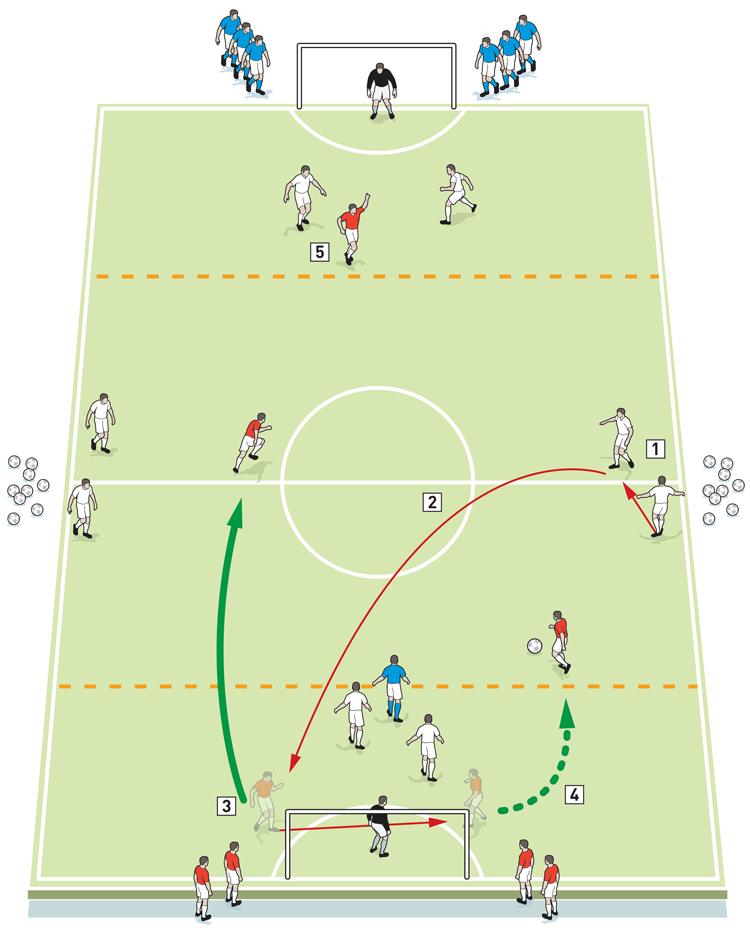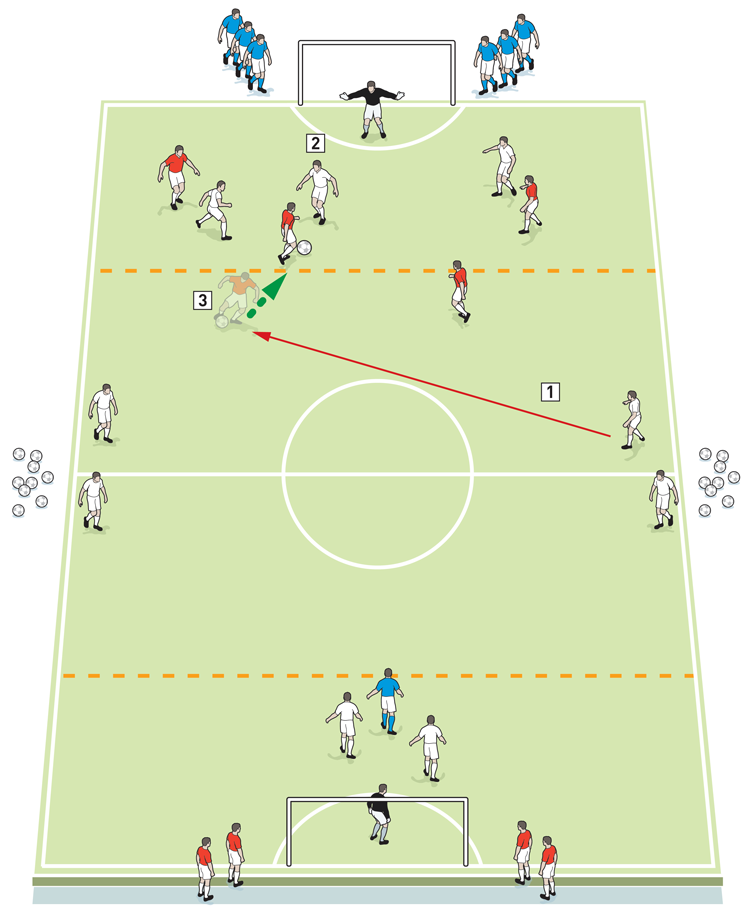You are viewing 1 of your 1 free articles
Counter-attacking short and long
This session covers accuracy of passing both in deep areas of the pitch and in and around the goal. It also showcases combination play of centre-forwards and finishing techniques, third man running and defending situations when outnumbered.
| Area | 80x60 yards |
| Equipment | Balls, cones, goals |
| No. of Players | Full squad |
| Session Time | 4x4min drill |
This session covers accuracy of passing both in deep areas of the pitch and in and around the goal. It also showcases combination play of centre-forwards and finishing techniques, third man running and defending situations when outnumbered. In short, it’s a session that tests every player involved, from the keeper, who has to make sure his angles are right, to ball-carrying midfielders and combination strikers.
Yet at the heart of this practice is short and long passing in counter-attacking moves. The ability to use the ball smartly with expectation, vision, accuracy and speed is vital in moving from one end of the pitch to the other and, with that in mind, this is a session we will practise at least once a week, usually midweek.
Players will require a lot of energy in order to fully embrace the challenges of the drill, always being required to operate quickly and under pressure, so not only do we want them to approach the challenges fresh, they’ll also need a small recovery period afterwards.
What do I get the players to do?
As shown (1a), we set up in the area between the 18-yard boxes (or approximately 80x60 yards). Using short and long passes the move prompts a counter-attacking break into opposition territory that is played to a finish (1b).
1a

2. They play one-two with each other, ending with a diagonal pass to one of the two midfielders waiting on either side of the goal
3. Once the receiving player controls the diagonal ball he then passes it across the six-yard box to his partner
4. This man then runs with the ball at speed to the first line of flat cones
5. When the midfielder hits the first line the centre-forward becomes active
1b

2. The 3v2 then becomes playable with both midfielders and the centre-forward up against two defenders
The drill restarts after the ball has gone dead, is with the keeper, or defenders have cleared. Now, from the end of the pitch where the previous passage of play finished the other two resting defenders play a one-two and a long diagonal pass into the next two midfielders.
What are the key things to look out for?
Technically, the power, pace and accuracy of the long ball that starts the session is so important for the drill to begin with positivity and momentum, but this must be accompanied by accurate, short passing. We want to see players mixing up this passing range throughout the practice for it to succeed.
In the next phase we’re looking for a concentrated first touch of the receiving player and good running speed from his partner. The strength and body position to receive the ball off the front player is also key.
Tactically the areas of the players’ runs are important, particularly with third-man midfield runs testing defensive players’ abilities to defend outnumbered.
In terms of typical mistakes, because there is a carrot for the players (namely a goalscoring opportunity) some will hold on to the ball for too long, increasing the chances of them being tackled and the move breaking down. Really, the key to this drill is to play quick, interchangeable passes (long and short) that move the opposition players into areas of the defensive third so as to create problems for them to deal with whilst keeping potential tacklers a good distance away.
How do I progress the practice?
We can progress the practice by adding another defender and centre-forward, as shown (2). After the first attack finishes (either with a goalscoring opportunity or a smart piece of defensive play) another ball is played into the middle of the pitch with the attacker having a timed challenge, such as score within 10 seconds.

2. The three defenders need to squeeze the pitch area
3. The attacker who retrieves the ball has 10 seconds to attack one of the defenders in a 1v1 situation, before trying to score a goal
How do I put this into a game situation?
To conclude with a small-sided game scenario, we can set up in two penalty boxes back-to-back to rehearse the defending aspect of this drill. Namely, we can construct 1v1, 2v2, 3v3 and 4v4 drills to further play out the short and long ball principles practised.
Related Files
Editor's Picks
Using the goalkeeper in build-up play
Pressing principles
Intensive boxes drill with goals
Penetrating the final third
Creating and finishing
My philosophy
Pressing initiation
Compact team movement
Defensive organisation
Coaches' Testimonials

Alan Pardew

Arsène Wenger

Brendan Rodgers

Carlos Carvalhal

José Mourinho

Jürgen Klopp

Pep Guardiola

Roy Hodgson

Sir Alex Ferguson

Steven Gerrard
Coaches' Testimonials

Gerald Kearney, Downtown Las Vegas Soccer Club

Paul Butler, Florida, USA

Rick Shields, Springboro, USA

Tony Green, Pierrefonds Titans, Quebec, Canada
Join the world's leading coaches and managers and discover for yourself one of the best kept secrets in coaching. No other training tool on the planet is written or read by the calibre of names you’ll find in Elite Soccer.
In a recent survey 92% of subscribers said Elite Soccer makes them more confident, 89% said it makes them a more effective coach and 91% said it makes them more inspired.
Get Monthly Inspiration
All the latest techniques and approaches
Since 2010 Elite Soccer has given subscribers exclusive insight into the training ground practices of the world’s best coaches. Published in partnership with the League Managers Association we have unparalleled access to the leading lights in the English leagues, as well as a host of international managers.
Elite Soccer exclusively features sessions written by the coaches themselves. There are no observed sessions and no sessions “in the style of”, just first-hand advice delivered direct to you from the coach.









